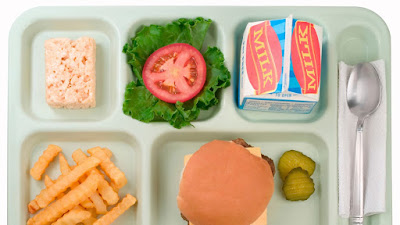The Evolution of the School Lunch Menu
For anyone in their 30s
or older, it comes as no surprise that over the past two decades, America’s
palate has evolved and diversified. Tuna casserole and meatloaf dinners have
been replaced with meals that have much bolder flavors influenced by many ethnic
backgrounds. This CNBC article from 2017 that
discussed this trend came to this conclusion about how and why this evolution
has occurred: “The changing culinary landscape is the result of increased
social media and television coverage that expand consumer awareness, and
millennial eaters who are more adventurous and experimental with their food
choices.” As you might expect, the changing palate for adults also means a new
palate for kids, and that has had a big impact on school lunch programs from
coast to coast.
Recently, I brought an
old friend from high school who hasn’t stepped foot in a school since we
graduated twenty years ago through the school lunch line in the New Hampshire high school where I
am the principal. She was astonished at the menu options available to my
students. That day, the speciality line was trying out some new Asian fusion
dishes. For kids who were hesitant to try something new, they were offering
free samples. In other parts of the kitchen, kids were gravitating towards some
of their favorite stand-bys of make-your-own sandwiches or the salad bar. At
the pizza station, a tomato-basil-fresh mozzarella pizza was being sliced up
with a side of kale chips. Our kitchen staff regularly asks students for their
feedback and tries to incorporate their ideas into new menu options. For my
friend, this was a foreign concept to the school lunches we remember from the
mid to late 90s. Then, meals were one-size-fits-all, and nutrition and flavor
came second to cost and convenience for the school to produce the meal. Without
question, today’s school lunches have evolved considerably.
While our country has
been on a quest for bold new flavors for its lunch program, it has also
navigated the sometimes tricky waters of adhering to the ever-increasing
nutritional standards set forth in federal guidelines for reimbursable meals.
This is not necessarily a bad thing as many studies such as this one published last year by the
Atlantic point to a strong correlation between healthy school lunches and
academic test scores. In the article, Sean Patrick Corcoran, an associate
professor of economics and education policy at New York University Steinhardt
School of Culture, Education, and Human Development, stated: “I've seen a
number of other rigorous studies that also find a connection between healthy
eating and academic performance,” he said. “Students who eat regular, healthy
meals are less likely to be tired, are more attentive in class, and retain more
information.” And he said some effects are almost immediate: “Even when schools
serve calorie-rich food on test day, students perform better on those tests.”
The struggle to provide
healthier, diversified, and cost-effective menu options have left many schools
with more questions than answers. Indeed, this New York Times article
described how the regulations were turning kids away from school lunches. In
schools across America, fruits and vegetables were being scraped off of lunch
trays and into the trash. The article quoted a recent survey that concluded,
“Children consumed fewer [fruits and vegetables] and wasted more [fruits and
vegetables] during the school year immediately following implementation of the
USDA rule that required them to take one fruit or vegetable at lunch.” It seems
now that there is a push in Washington to relax some of the regulations to
combat this issue. As a result, many schools like mine are starting to
experiment with menu options or choices to bring students back through the
lunch lines.
This recent EdWeek article discussed an interesting new trend
of private restaurant and catering options for parents for their children. The
article highlighted entrepreneur Lisa Farrell, who recently launched Red Apple Lunch, a business that
prepares healthy lunches with local foods (when possible) and delivers them to
either homes or, directly to schools (if school rules allow for this). Their
business model is based on the idea that kids don’t always like or want the
school lunch option, but parents don’t have the time to prepare an alternative
lunch. Schools that allow delivery of such lunches are setting themselves up
for what could be an interesting debate over whether or not schools have an
obligation to ensure all students have access to the same high qualities meals
or not. This will be an interesting debate to follow as we embark on a new
school year.




Comments
Post a Comment